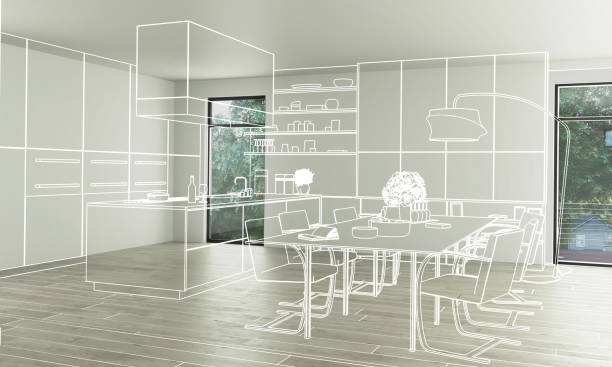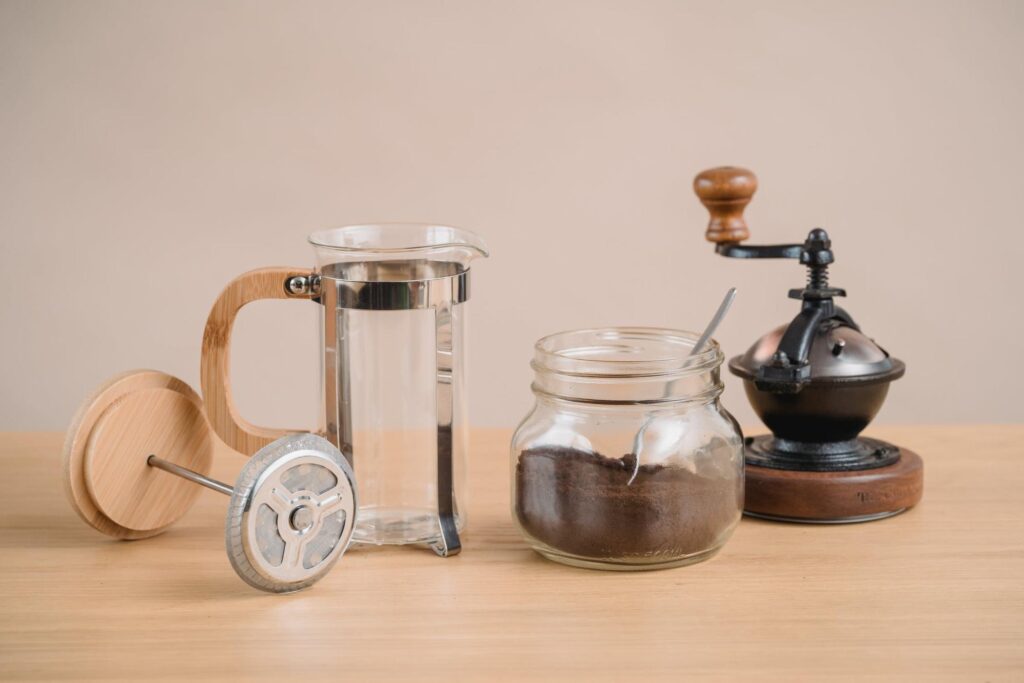Picture yourself standing in your dream kitchen that is both spacious and luxurious. If this resonates with your vision, it’s time to turn that dream into reality. With the idea of kitchen remodel simmering in your mind, Bath & Kitchen Galleria is here to assist you in working out your kitchen remodel checklist.
You are planning to go for a kitchen remodel but are not sure where to start. No worries, as our expert designers are the best in the business of custom kitchen renovation. We’ll guide you throughout the process to achieve your ultimate goal.
Let’s begin with our step-by-step kitchen remodel guide to help you give your kitchen a makeover.
Step-by-Step Guide to Kitchen Remodel
Our comprehensive kitchen reno checklist ensures every detail is covered, making your journey to a dream kitchen seamless and exciting. From functionality to style, let’s transform your kitchen into a blend of beauty and practicality!
1. Initial Planning

Setup a Blueprint
When planning your kitchen renovation, start by creating a detailed wishlist. List everything, from the type of cabinets to your chosen color scheme. If you have a specific theme or inspiration in mind, add that to your list too. This will be a great help when discussing plans with us.
To keep the renovation process smooth, prioritize each item with a number on your kitchen remodeling checklist. This way, you’ll know what to focus on first and can manage the project more efficiently.
As Louis Parrish once said, “Organizing your kitchen is a step towards organizing your life.” A well-planned kitchen renovation can bring order and joy not just to your space, but to your daily routine as well.
Evaluate Your Current Kitchen
Start your kitchen renovation journey with a thorough evaluation of your existing space. Take a close look at the current layout, cabinets, and fixtures. Identify which elements might still have value and could contribute to your renovation budget through a good ROI.
Many homeowners jump straight into demolition, but it’s wise to first assess what you already have. Check the condition of your in-use cabinets, range, and appliances. If they’re still functional and fit well with your new design, consider keeping them. This not only aids in cost-saving but also adds an element of sustainability to your renovation project.
Identifying Pain Points
People often plan kitchen remodeling because the current design isn’t fully functional or looks outdated. Make two columns and write down everything you like about ‘how it is’ and ‘how it should be’.
This way, we will be in a better position to understand your needs and make the right decision for you. Bath & Kitchen Galleria carefully plans and evaluates, ensuring a smoother and more efficient kitchen remodeling process for you.
Hire a Professional
When it comes to kitchen renovations, choosing the right professional is key. An experienced and skilled contractor, like those at Bath & Kitchen Galleria, can be the difference between a dream kitchen and a costly mistake. They understand how to work within your budget and cater to your comfort and style preferences.
TIP #1: In your search for the perfect contractor:
- Don’t solely rely on word of mouth; take the time to research local kitchen contractors and set up meetings to discuss your project.
- Speak with their previous clients to get a sense of their work quality and reliability.
- Recommendations from friends and family can be invaluable. They can share their firsthand experiences and suggest contractors with whom they’ve had positive outcomes.
Important: You’ll need to schedule the renovation project around your contractor’s availability. Bath & Kitchen Galleria due to high demand stays busy around the year and we thus recommend booking a few months before the project to avoid unnecessary delays.
Look For Local Permits
Obtaining local permits to ensure compliance with building codes is a must-have of every kitchen renovation checklist. Otherwise, the renovation may face legal and safety issues.
According to the Atlanta Department and City Planning, certain kitchen repair or renovation projects may be exempt from obtaining a permit if the total valuation is under $10,000, adhering to Ordinance 17-O-1307 and meeting minimum code requirements.
Many minor plumbing, electrical, and installation changes don’t necessarily require a permit. However, a permit is needed if exterior work is involved in a landmark governed by Chapter 20.
2. Defining Goals and Budget

When crafting your checklist for a kitchen remodel, it’s essential to allocate a specific budget for each component. Avoid making assumptions about the overall cost and diving headfirst into the project.
At the outset of your kitchen remodeling journey, it’s natural to envision a grand outcome. However, this focused approach, guided by a well-planned checklist for a kitchen remodel, ensures that your resources are allocated effectively, balancing your dream design with practical financial management.
Long-Term Investment Vs. Immediate Expense
Keep in mind that a kitchen upgrade is not just an immediate expenditure; it’s a long-term investment that can yield significant returns. Before allocating funds for your kitchen renovation, think about your future objectives.
Our research shows that kitchen renovations often lead to a substantial ROI, with an average ROI ranging between 70-80%. By investing about 10-15% of your home’s value in a kitchen remodel, you’re not just enhancing its functionality and aesthetic appeal but also fixtures potentially boosting its market value considerably. This strategic investment can pay off handsomely in the long run.
Cost Breakdown of Kitchen Remodel Elements
Any kitchen remodel checklist is incomplete without determining the cost breakdown of essential elements. We divide them into two categories:
| ITEM | ESTIMATED COST RANGE |
| MAJOR COSTS | |
| Cabinets | $5,000 – $20,000+ |
| Appliances | $3,000 – $15,000+ |
| Countertops and Backsplash | $2,000 – $10,000+ |
| Lighting Fixtures | $500 – $5,000+ |
| Labor | $3,000 – $10,000+ |
| HIDDEN COSTS | |
| Plumbing | $1,000 – $5,000+ |
| Electrical Work | $1,000 – $5,000+ |
| Permits and Inspections | $500 – $2,000+ |
| Unexpected Repairs | $1,000 – $10,000+ |
| Trash Removal/Disposal | $300 – $2,000+ |
Choosing Materials: Cost Vs. Quality
The allure of high-end materials to enhance the aesthetic of your dream kitchen is understandable, but budget constraints often call for a more practical approach.
When selecting materials, prioritize functionality, considering their durability, stain resistance, and moisture tolerance. Be aware that opting for more economical options might involve trade-offs in performance and longevity.
Opting for budget-friendly materials can offer immediate cost savings in your remodel. However, it’s crucial to weigh these upfront savings against the potential long-term expenses of repairs or replacements. This careful consideration ensures that your choices align not only with your current budget but also with future maintenance and upkeep.
Labor Costs: DIY vs. Professional Help
A DIY kitchen renovation is both an exciting venture and a tough call. It demands a certain skill level, time commitment, and efficient management skills. However, the cost benefits of DIY may fall short if mistakes lead to costly corrections or the project doesn’t meet expectations.
Choosing to invest in professional help, like the skilled team at Bath & Kitchen Galleria, often pays dividends in the long run. The choice is personal but with understanding of the specific demands of a custom kitchen remodel ensures that your vision is realized with precision and care.
Budgeting for Unforeseen Expenses
Preparing for unexpected expenses is crucial for a smooth kitchen renovation. You might encounter hidden structural issues or surprise permit costs, so it’s important to be ready.
Having a contingency fund helps you handle unforeseen situations, like plumbing surprises, without stress. This extra budget ensures you can manage any twists and turns during your renovation journey.
3. Design and Layout

Optimal Space Utilization
The kitchen is a hub of day-to-day operations and needs to be designed to ensure functionality, efficiency, and a welcoming atmosphere. Since you have specific square footage to redesign your kitchen, make the most of every inch by employing clever design strategies.
- Thoughtful Layout: Imagine starting your morning routine in a kitchen where the coffee maker, mugs, and breakfast essentials are within easy reach. Saving time and effort during busy hours is a perk of a well-thought-out layout.
- Smart Storage Solutions: Keeping your heart of home organized is achievable by installing the proper storage units. Innovative storage solutions, like deep drawers for pots and pans, declutter your space yet make every utensil accessible.
- Workflow Efficiency: You must have heard of the work triangle, right? Always try to place prep areas, cooking zones, and cleanup stations to create a logical sequence. This minimizes unnecessary steps, allowing you to navigate your kitchen with ease and efficiency.
- Traffic Flow: Clear pathways and designated zones for different tasks to prevent interruptions during your kitchen activities. It allows family and guests to navigate around the kitchen effortlessly, even when someone is busy cooking.
TIP #2: Indeed kitchen islands are a smart addition to modern kitchens as they cater to various purposes. They serve as an extra workspace for multiple cooks, provide a platform to accommodate appliances like a built-in oven or sink, offer a convenient seating area for quick meals, and can even transform into a stylish bar for entertaining guests.
We recommend a kitchen island only if you have ample space in your kitchen layout. If not, you always have an alternative.
TIP #3: If space is limited, a practical alternative could be a peninsula. A peninsula offers similar functionality, extending from existing countertops, providing additional workspace, and serving as a casual dining area, all while maximizing available space in a more compact setting.
Countertops Exuding Style and Functionality
(A) Material Selection
- When choosing countertop materials, consider your lifestyle and aesthetic preferences.
- Granite offers durability and natural beauty, while quartz provides low maintenance and a wide range of colors.
- Marble exudes elegance but may require more care.
- The butcher block adds warmth and is ideal for avid cooks.
- Assess these options, weighing durability, maintenance, and visual appeal against your budget.
(B) Design
- Harmonizing your countertop design with the overall kitchen theme is crucial.
- Ensure the chosen material complements cabinetry and flooring.
- Explore edge profiles—beveled, bullnose, or waterfall—to add a unique touch.
- A cohesive color palette enhances the aesthetic unity of your kitchen.
(C) Maintenance
- Promptly address spills to prevent stains and preserve the pristine appearance of your chosen countertop surface.
- Different countertop materials necessitate distinct care routines.
- Seal natural stone surfaces like granite and marble periodically to safeguard against stains.
- Quartz, being non-porous, requires just simple cleaning.
- For butcher blocks, regular application of food-safe mineral oil prevents drying and maintains resilience.
TIP #4: Use cutting boards to protect against scratches. Avoid placing hot pans directly on the surface and use caution with sharp objects to prevent unnecessary wear.
Aesthetic Kitchen Cabinetry and Hardware
The color selection, materials, finishes, and design theme, everything must synchronize with other rooms ensuring a cohesive and unified aesthetic. Otherwise, your living space will lack harmony.
The choice of materials for kitchen cabinetry is limitless. With needs and demands evolving daily, you’ll find yourself overwhelmed when visiting the showroom for hardware purchases.
That’s why hiring a general contractor like us goes a long way. They understand the right configuration for your kitchen and can assist you in ordering cabinets that align with your design and functionality needs.
Kitchen cabinetry is the most crucial element, not only for storage but also to make a statement in your overall kitchen design.
(A) Styles:
- Traditional, contemporary, farmhouse, or rustic, draw your inspiration from Pinterest or let the designer take care of it.
- Shaker-style cabinets are highly appreciated for simple, clean lines with a classic and versatile design.
- Raised panel cabinet doors give a more artistic look but come with a heavy price tag.
- Install glass front cabinets to flaunt your exclusive dishware.
- Consider getting rustic country-style cabinets for your love of mother nature.
(B) Materials:
- From solid wood to stainless steel and laminate, you will find numerous options to choose from.
- While laminate, thermofoil, and MDF are inexpensive materials, they don’t have a good durability profile.
- If you intend to expand your budget, consider investing in plywood, solid wood, or stainless steel cabinets, as they’re known for their longevity and robustness.
(C) Finishes:
- Painted finishes offer versatility and wide color options and are low-maintenance.
- Though color options are limited, a stained finish brings warmth and offers a timeless option to treasure.
- The weathered appearance of the distressed finish adds character. However, people rarely like it.
- Laminate is both affordable and resistant to stains, but you must be careful around it with sharp objects.
(D) Other Important Concerns:
Don’t overlook the minor details and ask yourself the following questions while preparing the kitchen design checklist:
- What are the different types of cabinet hardware?
- Should I use knobs or pulls on kitchen cabinets?
- Can I mix knobs and pulls in a kitchen?
- Is it cheaper to paint or replace older cabinets?
- Should kitchen cabinets be lighter or darker than walls?
- What color cabinets show the least dirt?
4. Smart Appliance Selection

In a high end kitchen remodel, electric appliances hold significant importance. Careful consideration before splurging on appliances can prevent you from inadvertently breaking the bank, ensuring that each addition to your kitchen serves a purpose.
TIP #5: Always avoid impulse buying and never fall into the trap of deluxe, feature-packed appliances.
A few more things that may help you buy kitchen appliances are discussed below:
Types of Appliances to Consider in Your Kitchen
Consider the different categories while exploring the types of appliances. Because you don’t need to have all of them in your kitchen. Whatever you pick, make sure it’s not going to end up collecting dust while sitting on the nook of the countertop.
Everyday Essentials:
- Fridge
- Stove
- Microwave
- Dishwasher
Baker’s Delight:
- Oven
- Electric whisk
- Food processor
- Mixer/ blender
Convenience Choices:
- Air fryer
- Toaster oven
- Coffee maker
Efficiency
Save as much as up to 30% on your electricity bills by investing in energy-efficient appliances. This not only enhances the functionality of your kitchen but also contributes to long-term savings and environmental sustainability.
For instance, when choosing a refrigerator, prioritize models that offer advanced temperature control and energy-saving features. Look for the Energy Star label, a guarantee that the appliance meets stringent energy efficiency standards.
Safety Features
Safety is a top priority in any kitchen, especially when it comes to the stove, which is a central element. It’s essential to choose gas stoves that are equipped with advanced safety features, such as automatic shut-off mechanisms that activate if the flame goes out.
TIP #6: Electric stoves with induction technology provide an added layer of safety and offer a safer alternative. They heat only when in contact with compatible cookware and reduce the risk of burns, especially in households with kids.
Convenience
Prioritizing user-friendly kitchen appliances can greatly simplify your daily routine. Consider modern dishwashers that come with features like adjustable racks, intuitive controls, and easily accessible buttons, making dishwashing less of a chore.
Similarly, ovens with advanced controls and precision settings provide a more efficient and hassle-free cooking experience, enhancing your overall kitchen functionality.
Conclusion
This comprehensive guide has walked you through the essential steps, from initial planning and budgeting to design considerations, material choices, and smart appliance selection.
By following these steps, you’re well-equipped to transform your kitchen into a space that not only meets your immediate needs but also stands the test of time with style and functionality.



